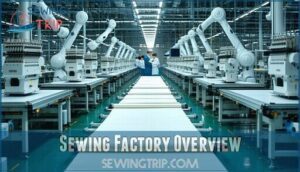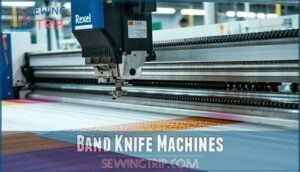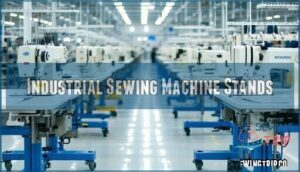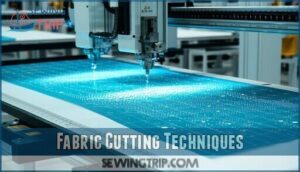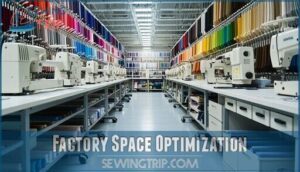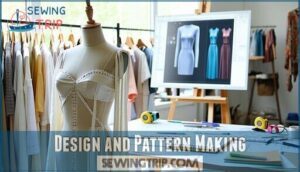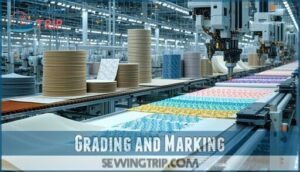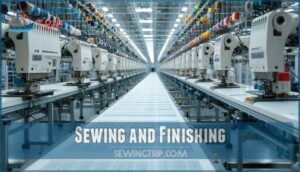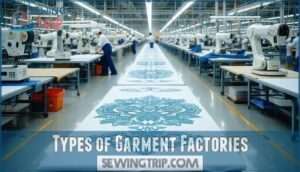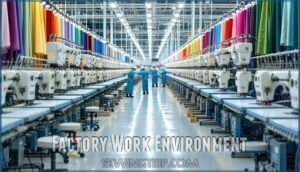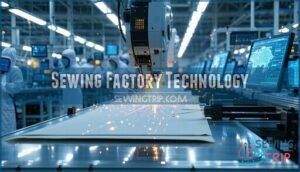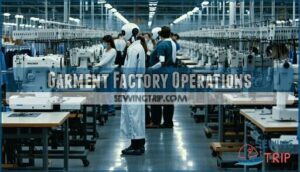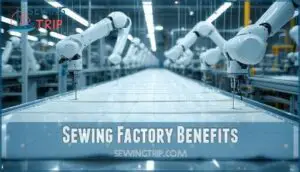This site is supported by our readers. We may earn a commission, at no cost to you, if you purchase through links.
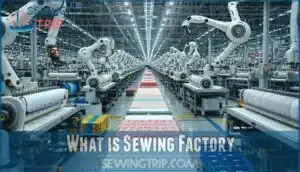 A sewing factory is where fabrics and materials come to life, turning into those clothes you love to wear.
A sewing factory is where fabrics and materials come to life, turning into those clothes you love to wear.
It’s a fast-paced hub filled with industrial sewing machines, skilled workers, and precise processes.
From cutting fabric to stitching seams, every step brings a design closer to reality.
Think of it as a blend of artistry and engineering, where technology and human craftsmanship work hand in hand.
Quality control is a big deal here, ensuring garments meet the highest standards before heading to stores.
Curious how every thread counts in creating your favorite outfits? There’s so much more to uncover!
Table Of Contents
- Key Takeaways
- Sewing Factory Overview
- What is Sewing Factory
- Sewing Factory Equipment
- Factory Space Optimization
- Garment Manufacturing Process
- Types of Garment Factories
- Factory Work Environment
- Sewing Factory Technology
- Garment Factory Operations
- Sewing Factory Benefits
- Frequently Asked Questions (FAQs)
- Conclusion
Key Takeaways
- You’ll find sewing factories transforming raw fabrics into finished garments through structured processes like cutting, stitching, and quality control.
- They combine advanced machinery with skilled workers to efficiently produce clothing at various scales for global fashion brands.
- Quality control is a priority, with modern inspection systems ensuring garments meet high standards before distribution.
- Sewing factories balance creativity and efficiency, using technology to streamline production while preserving craftsmanship.
Sewing Factory Overview
You’ll find that a sewing factory transforms raw textiles into finished garments through structured processes like pattern making, cutting, stitching, and quality control.
These specialized production facilities employ skilled workers and advanced machinery to efficiently manufacture clothing on a large scale for fashion brands worldwide, utilizing complete concepts in their operations.
Factory Processes and Operations
Inside a modern sewing factory, you’ll find a carefully orchestrated symphony of processes.
A modern sewing factory operates like a finely tuned orchestra, with every process harmonized to create perfection in garment production.
From initial design and pattern making to precision fabric cutting and skilled machine sewing, every step follows lean manufacturing principles.
Today’s operations integrate automation with traditional craftsmanship, optimizing workflow while reducing waste.
Quality inspection happens continuously, not just at the end, ensuring each garment meets exacting standards before it moves to finishing, packaging, and distribution stages, which is a key part of the manufacturing principles and helps achieve a carefully orchestrated workflow.
Fabric Cutting and Sewing Machines
The backbone of any sewing factory lies in its specialized equipment.
You’ll find industrial cutting machines designed for precision and volume, capable of handling multiple fabric layers simultaneously.
Modern sewing machines operate at speeds unimaginable in home settings, with specialized functions for different stitch types.
The ergonomic design of these machines considers operator comfort during long production shifts, while automation impacts productivity by reducing manual labor requirements.
These factories often use fabric cutting machines to enhance precision.
Quality Control and Factory Management
With your precision sewing machines in place, you’ll need robust quality control systems to monitor production.
Modern inspection technology uses cameras and sensors to catch flaws in fabric, stitching, and construction before they become costly problems.
Documentation accuracy is paramount—factories maintain detailed tech packs, fabric libraries, and vintage references in binders.
These records protect against shipping disputes while providing design inspiration. Defect rectification happens immediately, keeping manufacturing efficiency high and workflow optimization possible.
What is Sewing Factory
Now that you’ve seen how factories operate, you might wonder what exactly defines a sewing factory.
A sewing factory is a specialized manufacturing facility where raw textiles are transformed into finished garments through structured production processes.
You’ll find these establishments serving as the backbone of the global apparel industry.
What sets sewing factories apart from other manufacturing facilities:
- Production Scale – They handle everything from small batch production to massive orders for global brands
- Specialized Workforce – Teams of skilled workers perform specific tasks in the garment creation pipeline
- Purpose-Built Equipment – Facilities house industrial-grade machines designed specifically for textile work
- Integrated Processes – They combine cutting, stitching, finishing, and quality control under one roof
In today’s clothing factory landscape, these facilities form the critical link between design concepts and the finished products hanging in your closet.
Sewing Factory Equipment
You’ll find a range of specialized machinery in modern sewing factories, from precision band knife cutters to industrial-grade sewing machines on ergonomic stands.
These essential tools enable manufacturers to transform raw fabric into finished garments with efficiency and consistency that wasn’t possible just a decade ago.
Band Knife Machines
Band knife machines serve as the cornerstone of modern sewing factories, allowing for precise cutting of multiple fabric layers simultaneously.
Band knife machines revolutionize garment production with unmatched precision, cutting through multiple fabric layers effortlessly for flawless results.
You’ll find these specialized tools equipped with razor-sharp blades that slice through materials with remarkable cutting precision.
The Rexel Band Knife, particularly the R1250 model, offers adjustable cutting speeds up to 18 m/s, making it indispensable for both small workshops and large-scale textile cutting operations.
These machines are available for purchase online here, providing a convenient option for those looking to acquire a band knife machine for their sewing needs.
Industrial Sewing Machine Stands
While your sewing machines perform the heavy lifting, industrial sewing machine stands provide the essential foundation for your entire operation.
These stands guarantee proper ergonomics, reducing operator fatigue through ideal height positioning.
You’ll find various options like the REX-1 for lighter JUKI machines or the REX-8 for detailed work.
Most stands offer vibration reduction through quality stand materials, and some feature mobility options for flexible factory layouts.
Explore options for reliable sewing platforms to enhance your workspace.
Fabric Cutting Techniques
While industrial stands support your sewing operations, the right fabric cutting techniques determine your project’s success from the start.
You’ll find various approaches like bias cutting (at 45-degree angles) for stretch and flexibility, or layered cutting which distinguishes warp and weft threads for proper garment hang.
Modern textile cutting machines—from precision cutting band knife machines to laser cutters—handle everything from intricate patterns to synthetic materials, revolutionizing pattern matching and automation integration in today’s factories.
Factory Space Optimization
You’ll find modern sewing factories maximizing every square inch due to thin profit margins and expensive real estate in fashion hubs.
They’re utilizing vertical storage solutions, under-table compartments, and wall-mounted patterns to accommodate materials and workflow efficiently in otherwise cramped spaces.
Thin Profit Margins
The sewing factory’s thin profit margins are your manufacturing reality, typically ranging from 5-20% compared to brands’ 50-200%.
In the fashion industry, these tight margins necessitate strategic cost reduction and efficiency improvement at every step.
To remain competitive, successful garment industry operations implement precise pricing strategies while constantly seeking value addition opportunities.
Market competition forces factories to maximize every production dollar, making lean operations not just preferred—but essential for survival in the fashion business.
Expensive Real Estate
Real estate prices in fashion hubs create a significant financial burden for sewing factories.
You’ll notice urban factories constantly battling sky-high rental costs, forcing owners to maximize every square inch of available space.
Location impact is substantial—moving to cheaper areas risks losing clients due to inconvenience, which can further squeeze profit margins.
Many successful operations choose to stay put, optimizing their limited factory space rather than relocating, despite the financial challenges they face.
Vertical Storage Solutions
With limited square footage costing a fortune, factories turn to the sky for solutions.
You’ll see vertical storage systems everywhere in a busy sewing factory—fabric rolls stacked to the ceiling and wall-mounted patterns maximizing every inch.
These space maximization techniques guarantee inventory accessibility while maintaining factory operations flow.
Custom solutions like overhead racks and hanging systems keep materials organized yet readily available, balancing safety considerations with cost analysis for maximal factory space optimization.
Many factories are now implementing automated storage solutions to further improve efficiency.
Garment Manufacturing Process
You’ll witness your clothing come to life through a structured process that transforms raw fabric into finished garments, beginning with design and pattern making before progressing through cutting, sewing, and finishing operations.
The modern garment manufacturing process combines traditional craftsmanship with advanced technology, ensuring efficiency and quality as your designs move systematically from concept to completed product, utilizing advanced technology to achieve this goal.
Design and Pattern Making
Before the first stitch is sewn, design and pattern making lay the foundation for every garment.
You’ll find that the design process begins with extensive trend research and digital design techniques using CADs.
Pattern makers then transform these fashion design concepts into tangible templates, often creating multiple prototypes until the fit is perfect.
Design innovation happens continuously throughout this stage, ensuring your garment will meet both aesthetic and functional requirements.
Grading and Marking
With your pattern complete, it’s time for grading and marking—where your single-size design becomes production-ready.
Grading creates different size variations of your pattern, either horizontally or vertically.
Marking strategically places these patterns on fabric to maximize fabric utilization and optimize costs.
Think of it as solving a puzzle where every inch matters.
In today’s factories, computer systems calculate the most efficient marker layout, reducing waste while maintaining design integrity.
Sewing and Finishing
With your patterns marked and cut, it’s time for the heart of garment creation: sewing and finishing.
You’ll join fabric pieces using various stitch types on specialized sewing machines, from basic straight stitches to decorative options.
Thread selection impacts both durability and appearance.
After assembly, finishing operations transform raw edges with seam finishes while pressing methods create crisp lines.
Types of Garment Factories
You’ll encounter several distinct factory types when exploring clothing production, including cut and sew operations for custom garments, mass production facilities for retail chains, and private-label manufacturers offering custom branding services.
Each factory type serves specific market segments and production scales, with specialized equipment and workforce skills adapted to their particular manufacturing focus.
Cut and Sew Factories
After understanding the manufacturing process, you’ll want to know about cut and sew factories – the artisans of garment manufacturing.
They’re perfect for small-scale production where craftsmanship emphasis matters, and your unique clothing line deserves this hands-on approach.
These specialized facilities transform raw fabrics into custom apparel from scratch, unlike other production methods, which gives you complete design control and fabric choices.
They combine traditional sewing factory techniques with personalized attention to detail, making them ideal for unique clothing lines that require a high level of customization.
Mass Production Factories
While cut and sew factories specialize in bespoke pieces, mass production factories operate on an entirely different scale.
You’ll find these garment manufacturing powerhouses churning out thousands of identical items daily. Their focus? Production volume and cost efficiency.
Modern mass production facilities integrate automation throughout the textile production process, maintaining quality consistency despite their size.
Their sophisticated supply chains enable your favorite retailers to stock shelves quickly and affordably. Understanding the importance of thread and seam types is essential for maintaining this consistency.
In today’s garment factory landscape, they’re the backbone of mainstream fashion.
Private-Label Factories
While mass production handles vast quantities, private-label factories offer a different approach to garment manufacturing.
They create clothing that carries your brand name but handle all production aspects themselves.
This arrangement lets you focus on marketing while they manage the sewing factory operations.
- Custom branding options include labels, hangtags, and packaging
- Design control remains in your hands while production scaling is managed professionally
- Lower minimums compared to traditional apparel manufacturing
- Legal agreements protect both parties throughout the manufacturing process
Factory Work Environment
You’ll find most sewing factories bustling with activity, as workers operate specialized machines amid fabric rolls stacked to the ceiling in cleverly optimized spaces.
When you visit the factory floor, you’ll notice the strategic layout designed to maximize productivity, with different sections dedicated to cutting, sewing, and quality control operations.
Worker Roles and Responsibilities
While garment factories come in different specializations, their operations rely on a well-orchestrated team of professionals with clearly defined responsibilities.
In a sewing factory, you’ll find a hierarchy of skilled workers, each with specific roles, and operators with specialized skillsets handle particular sewing techniques.
Supervisors oversee team dynamics and production flow, and training programs guarantee workers master complex operations, and safety protocols protect everyone on the floor.
Quality inspection teams examine finished pieces before shipping.
Factory Floor Layout
The typical sewing factory floor layout resembles a carefully choreographed dance of efficiency.
You’ll notice strategically placed machinery creating workflow optimization paths that minimize movement between stations.
Material flow follows logical sequences from cutting to finishing.
Machine placement adheres to strict safety regulations while incorporating ergonomic design principles to reduce worker fatigue.
In 2025’s modern sewing factories, equipment arrangement prioritizes both productivity and operator comfort, transforming what once seemed chaotic into purposeful design.
Showrooms and Archives
Behind every successful sewing factory, you’ll find well-organized showrooms and archives serving as treasure troves of vintage inspiration and design preservation.
During your factory tour, you’ll notice these spaces fastidiously maintain historical records of past productions alongside sample management systems.
These archives aren’t just storage—they’re accessible resources where designers draw inspiration from previous collections, which is crucial for the evolution of craftsmanship.
When visiting a fashion factory, these showrooms often reveal the brand’s identity and how it defines the company, making them a valuable part of the factory’s heritage and a key to understanding the design preservation process.
Sewing Factory Technology
You’ll find modern sewing factories equipped with sophisticated technology that transforms traditional garment production into a high-precision, efficient process.
These facilities now utilize automated cutting machines, computer-aided design systems, and advanced quality control equipment that substantially reduce human error while increasing production speed and consistency.
Automated Cutting Machines
Automated cutting machines revolutionize a sewing factory, offering precision and speed in garment manufacturing.
Techniques like CNC cutting, laser cutting, and ultrasonic cutting handle intricate designs effortlessly, while plasma and waterjet cutting tackle tough textiles.
By reducing errors and boosting efficiency, these technologies streamline fashion manufacturing, making textile production faster, more reliable, and perfectly suited for today’s fast-paced industry demands with streamline fashion manufacturing.
Computer-Aided Design (CAD)
CAD software changes the way sewing factories approach fashion manufacturing. By enabling pattern digitization and design simulation, it streamlines garment production like never before.
Want a flawless fit? Virtual prototyping and automated grading take the guesswork out of textile production.
Online platforms now offer accessible pattern creation.
- Save time with precise clothing patterns.
- Reduce waste with detailed virtual samples.
- Bring bold ideas to life faster in garment manufacturing.
Quality Control Systems
You saw how computers shape designs, but what keeps garments flawless?
Sewing factory quality control uses statistical analysis, defect prevention, and inspection technology to guarantee apparel quality meets standard compliance.
Every piece undergoes process improvement checks, safeguarding garment quality.
It’s not just fashion quality control; it’s about crafting trust, keeping flaws out of the final product.
Garment Factory Operations
You’ll find that garment factory operations are all about precision, efficiency, and teamwork.
From sourcing the right fabrics to managing inventory and shipping, every step is carefully planned to produce quality clothing on a large scale, which requires teamwork.
Fabric Sourcing and Selection
Fabric sourcing’s like finding the soul of a garment.
You weigh fabric costs, review fiber properties, and balance weave types to match designs.
Color selection ties everything together, while sustainable fabrics offer eco-friendly charm.
Textile sourcing guarantees raw textiles meet production needs, blending practicality and creativity.
Thoughtful fabric selection builds quality clothing that tells your brand’s story.
Production Planning and Scheduling
In a sewing factory, production planning keeps things on track.
It blends demand forecasting, capacity planning, and workflow optimization to guarantee smooth operations.
Here’s how it works:
- Set Goals: Align output with demand to avoid delays.
- Divide Resources: Allocate workers and machines wisely.
- Spot Issues: Conduct bottleneck analysis early.
- Track Progress: Monitor the manufacturing process for efficiency.
To maintain quality, factories should also set clear standards for their products.
Inventory Management and Shipping
After planning production, it’s time to manage inventory and shipping logistics.
Smooth inventory tracking guarantees full shelves and prevents delays. Efficient warehouse optimization speeds up order fulfillment.
Here’s a breakdown of key steps:
| Process | Description | Benefit |
|---|---|---|
| Inventory Management | Tracks stock efficiently | Reduces stockouts |
| Shipping Logistics | Coordinates garment distribution | Cuts delivery delays |
| Packaging | Prepares orders for supply chain | Protects apparel quality |
Efficient warehouse optimization, smooth inventory tracking, and effective shipping logistics are crucial for successful order fulfillment.
Sewing Factory Benefits
Sewing factories streamline clothing production by boosting efficiency and ensuring consistent quality at every step.
They help brands meet customer demands with accuracy, speed, and reliability, making them indispensable in the modern fashion industry with consistent quality.
Increased Efficiency and Productivity
Efficiency in sewing factory operations thrives on automation integration and lean manufacturing.
Focus on workflow optimization reduces wasted time, while skill development enhances worker precision.
Strategic resource allocation guarantees every thread counts.
Manufacturing efficiency grows with technology streamlining processes, creating a seamless factory rhythm.
Production optimization is like choreography—each step perfectly timed to boost output and sustain a competitive edge.
Improved Quality Control and Accuracy
Quality control guarantees accuracy and prevents defects with standardized procedures, real-time monitoring, and operator training.
Here’s how to improve apparel quality inspection in sewing factories:
- Use statistical processes to analyze trends and catch flaws early.
- Train operators for precise garment inspection techniques.
- Implement real-time monitoring during textile inspections.
- Conduct thorough quality inspections before the finishing stage.
Accuracy matters, and following these steps ensures that quality control is effective in preventing defects and guaranteeing high-quality products.
Enhanced Customer Satisfaction and Loyalty
When a sewing factory meets garment quality standards with personalized garments or exclusive designs, customers notice.
Custom order tracking, responsive communication, and feedback integration help build trust.
Apparel quality inspection guarantees consistency, aligning with fashion quality standards.
By prioritizing textile quality and sewing factory quality standards, your factory enhances customer satisfaction and earns loyalty, creating lasting relationships that keep them returning, based on apparel quality.
Frequently Asked Questions (FAQs)
What is a sewing factory?
Imagine a bustling workspace where skilled hands transform fabric into clothing.
A sewing factory is a production hub that crafts garments through designing, cutting, and stitching processes, combining creativity, machinery, and precision to meet fashion demands, utilizing skilled hands to transform fabric into clothing.
What is the sewing industry called?
The sewing industry is often called garment manufacturing or apparel production.
It encompasses everything from fabric sourcing and pattern making to cutting, sewing, and finishing, driving the global fashion and clothing industry.
What is a cut and sew factory?
Think of a cut and sew factory as the architect of custom clothing.
It all starts from scratch—designs, patterns, fabric selection—then pieces are expertly cut and sewn into unique garments crafted to exact specifications.
What are the most common types of garments produced in a sewing factory?
The most common garments you’ll find produced in sewing factories include shirts, dresses, pants, coats, and skirts.
These basics cater to everyday wear, spanning casual to formal styles, and meet the high demand in global fashion markets.
What is the typical layout of a sewing factory?
When you get down to brass tacks, sewing factories feature a linear layout: fabric storage at one end, cutting and sewing stations in the middle.
The layout also includes finishing, packaging, and shipping areas at the other end.
What safety measures are taken in a sewing factory?
Factories prioritize safety by reinforcing proper machine use, offering protective gear, and ensuring adequate lighting.
Regular equipment maintenance, fire extinguishers, emergency exits, and first-aid kits are routine.
Training programs reduce accident risks and enhance awareness.
How much does it cost to set up and maintain a sewing factory?
Setting up a sewing factory costs $50,000 to $500,000+, depending on location, size, and equipment.
Annual maintenance can range $10,000 to $50,
Expenses include rent, electricity, machines, salaries, and materials—plan carefully to balance costs.
How much staff is typically employed in a sewing factory?
Think of a sewing factory as a bustling beehive—it usually employs anywhere from 50 to 500 workers.
The number depends on production scale, with roles like pattern makers, cutters, sewers, and quality inspectors.
How are environmental concerns addressed in sewing factories?
Sewing factories tackle environmental concerns by using eco-friendly materials, recycling fabric scraps, adopting energy-efficient machinery, and minimizing waste.
They also focus on lean manufacturing techniques to reduce environmental impact while ensuring responsible production practices.
What training programs are available for factory workers?
You can find programs teaching sewing techniques, machine operation, and quality control in technical schools, factory training centers, or online platforms.
Many companies offer on-the-job training to build skills while earning. It’s hands-on learning!
Conclusion
A sewing factory might seem like just a production space, but it’s where creativity and engineering collide.
Behind every garment is a mix of skilled hands, cutting-edge machines, and precise processes.
Whether it’s cutting fabric, stitching seams, or ensuring quality, every detail matters.
Understanding what a sewing factory is also deepens your appreciation of clothing and highlights the blend of artistry and efficiency shaping fashion in 2025.
Now, every thread truly counts!
- https://italian-artisan.com/
- https://www.youtube.com/watch?v=L1dH1PwNBSE&ab_channel=godonlyknowssarah
- https://garmentdistrict.nyc/
- https://www.linkedin.com/pulse/fabric-sourcing-garment-industry-comprehensive-guide
- https://www.eurofins.com/assurance/resources/articles/quality-control-in-garment-manufacturing/

